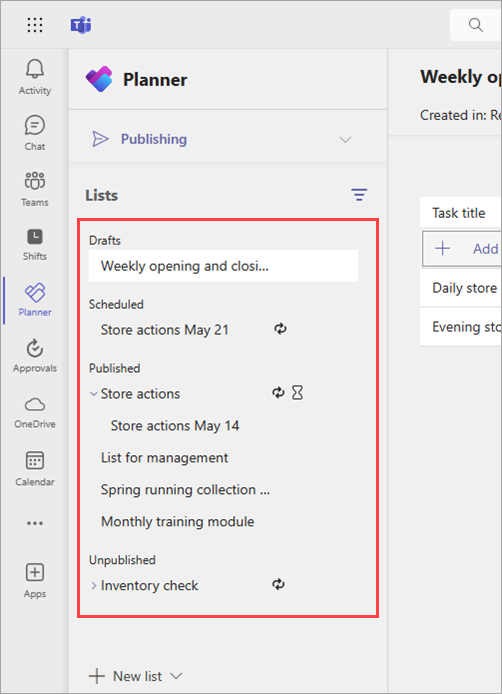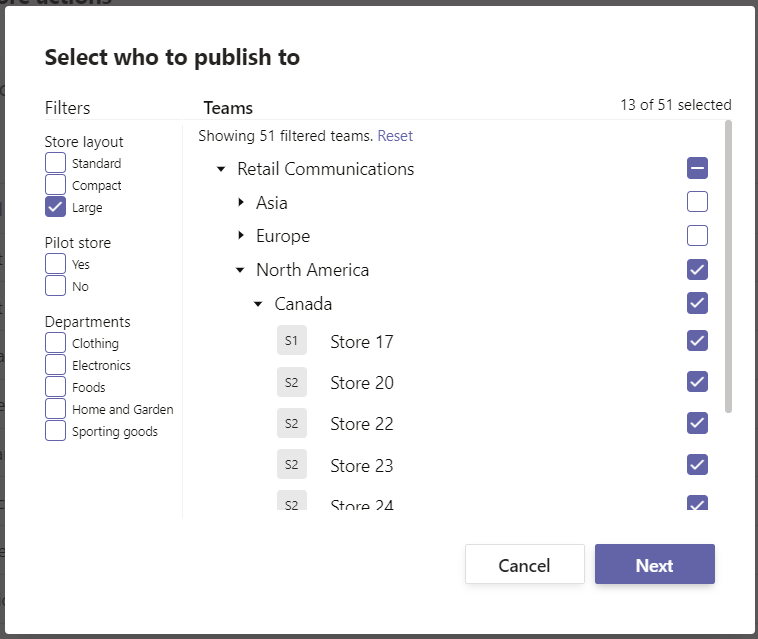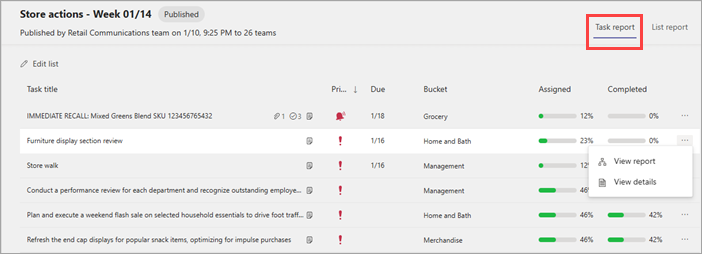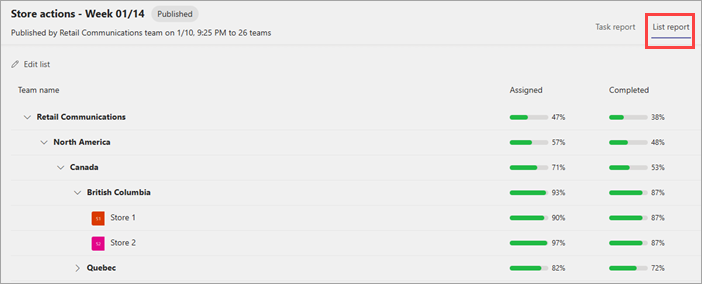
As an operations manager or similar business leader, you can centrally create a list of tasks for many teams in your org and monitor for completion of work. This feature is designed to make task management easier for organizations with frontline workers distributed across many different geographic locations.
This capability is available to you in the Planner app in Microsoft Teams if your organization enabled task publishing for you and your team.
In this article
Create a publishable task list
Make changes to a list that hasn't been published yet
Overview
With task publishing, your organization can centrally define tasks and distribute them to the teams who must perform the work. If enabled for you by your organization, you’ll find this functionality in the Planner app in Microsoft Teams.
In the task publishing experience, you start with a task list, which you can add tasks to. You have control over the details for each task in a list so you can add notes, set the priority, attach documents and photos, or apply requirements for completion. When you add at least one task to a task list, you can publish that list to the teams (locations) that you choose. After publishing a list, you’ll see a reporting view that reflects completion status of the work across locations, and:
-
Frontline workers can see all tasks assigned to them in the Planner app in Teams on mobile, desktop, and web.
-
Frontline managers can use Planner to track task progress and completion for their locations.
-
Organization leaders can use Planner to see task progress across all locations.
Frontline workers and managers won’t be able to delete the tasks published to their team. The title, notes field, and checklist item fields are also protected for published tasks, so frontline employees can't change the details of the work.
To create and publish task lists, go to the Publishing page in the Planner app.
Important: You'll only see the Publishing page if your organization enabled task publishing by uploading a hierarchy and you're a member of a team in that hierarchy. If publishing is available for you, the Publishing page allows you to broadly publish to teams you're not a member of. The My Tasks & Plans page shows your individual tasks for yourself and the tasks you're working on directly with teammates (in your teams and channels). Plans in My Tasks & Plans can't be published.
Before you get started
There are two types of task lists in task publishing. You can create lists with tasks for each team (known as standard task lists) and lists with tasks for each team member. Here’s more information about each type of list and when to use them.
|
List |
When to use |
Behavior when published |
Example |
|---|---|---|---|
|
Standard task list For each team |
For tasks that need to completed once per team. You can make these lists recurring. |
For each team selected, a single copy of the task is created in a plan for that team. As soon as one frontline manager or worker completes the task, it’s considered completed for the whole team. |
Reza, the operations manager at a manufacturing org, creates a task list for implementing a new production line. Reza publishes that list to the set of plant locations meant to pilot the new line. Each selected location receives one copy of the task. When any manager or worker there marks the task complete, it reflects as completed for the entire location. |
|
For everyone to complete For each team member |
For tasks that everyone on the team must complete. |
For each team selected, multiple copies of the task are created. For every member of the team, a copy of each task is created in a personal plan for that team member, and the task is assigned to that individual. All team members must complete the task for their location to reflect 100% completion of that task. |
Camille, the operations manager in a retail org, has a new workplace health policy that all employees must acknowledge. Camille publishes a task list with a task for reviewing and signing off on the new policy. Every employee at each selected location sees a task created for and assigned to them. Each employee must complete their own task. When a user marks their task complete, it won’t affect the tasks assigned to their teammates. |
You’ll see the following sections under Lists on the Publishing page: Drafts, Scheduled, Published, Unpublished. Each section represents a list state in the publishing process.
|
Section |
List state and behaviors |
Can tasks in the list be edited? |
Are tasks visible to members of the recipient team? |
|---|---|---|---|
|
Drafts |
Not yet published or scheduled for publication. |
Yes |
No |
|
Scheduled |
Scheduled to publish at a specified day and time. |
Yes |
No |
|
Published |
The list is published, or publishing is in progress. |
Yes |
Yes |
|
Unpublished |
The list is unpublished, or unpublishing is in progress. |
No |
No |
Note: Some users will also see a Received section where they see lists published to their team by teams higher up in the hierarchy. Most publishing users won’t see this section.
Create a publishable task list
-
At the lower left of the Publishing page, select New list, and then choose one of the following.
-
For each team. Use for tasks that need to be completed once per team, also referred to as a standard task list.
-
For each team member. Use for tasks that everyone on the team must complete, such as training or policy acknowledgement tasks.
Important: After you create a list with tasks for each team, you can’t change it to a list for each team member and vice versa. You’ll need to create a new list.
-
-
Name your list.
-
If you belong to more than one team that can publish, select the team to publish from. The teams that receive the task list publication will be able to see which team the task list was published from.
-
Select Create. The new list appears under Drafts.
-
Under Task title, give the first task a title, and select Enter.
-
Select the task title to open the task and add or edit any of the following.
-
Title
-
Bucket. Use to categorize tasks. For example, Warehouse or Sales Desk buckets could be used to identify the work group who will perform the task.
-
Priority. Options are Urgent, Important, Medium, and Low.
-
Start date or due date
-
Notes
-
A checklist of up to 20 items. You control the items, order, and whether the checklist is required for task completion. Task recipients control marking each item complete.
-
An attachment
-
Requirements for task completion. Task recipients must complete the requirements before they can mark the task complete. To learn more, see Set requirements for task completion in a task list.
-
Required form: Link up to two forms that task recipients must fill out. You can create a new form or use an existing form.
-
Required approval: Add an approval requirement for task recipients to request and receive approval from a manager. This is only available for tasks lists created using the For each team option (also known as standard task lists).
-
-
-
To add another task, enter a task name in the New task field.
Tip: After you create tasks, you can bulk edit the priority, due date, or bucket for all the selected tasks.
-
If you created your list using the For each team option (also known as a standard task list), you can make it recurring so that it automatically publishes on a repeating schedule. To do so, select Does not repeat, choose the recurrence settings for the list, and then select Save. To learn more about working with recurring task lists, see Use recurring task lists.
You can create a copy of any task list using the Duplicate action. This action creates a new list with a copy of the tasks in the original list. You can choose the name of the new list and which team it should be created for. Then, you can edit the tasks in the new list to prepare it for publishing.
-
Select the task list you want to duplicate, and then select More actions
-
Name the list and select the Publish from team. If you belong to more than one team in your organization’s hierarchy, you'll see multiple choices. The teams that receive the task list publication will be able to see which team the task list was published from.
-
Select Duplicate. After the list is duplicated, it appears under Drafts. You can interact with the list just like other draft lists.
Make changes to a task list that hasn't been published yet
-
Under Drafts or Scheduled, select the task list you want to edit.
-
To change a task, select its title to open the task, and then do one of the following:
-
To change any of the task's fields, select the field and edit as needed. You can also add or remove attachments and requirements.
-
To delete the task, to the right of the task name, select More actions
-
You can rename a draft list before you publish it.
-
Under Drafts, go to the list you want to rename, and then select More actions
-
Enter the new name in the Title box, and then select Save.
Important: You can't delete a list in the Published state or a recurring list series in the Scheduled state. You must first unpublish the list or cancel the list series and then unpublish it, which deletes all tasks in the list or lists from all recipient teams. After unpublishing the list or list series, it appears under Unpublished.
You can delete any task list under Drafts or Unpublished.
-
Under Drafts or Unpublished, go to the task list you want to delete.
-
Select More actions
Publish a task list
When your task list is ready to go, publish it to the teams whose members will do the work.
Note: After you publish a list, you can make changes to the tasks but you can't make changes to the teams selected to receive those tasks.
-
Under Drafts, select a task list, and then in the upper-right corner, select Publish or Publish series (if it's a recurring task list).
-
Choose how to select the recipient teams. You can select the teams from a hierarchy or upload a custom list of teams. Learn more about these options. The following steps show selection from a hierarchy.
-
Select the teams who will receive the task list. Use the main Teams list and/or any available filters to locate the teams to include.
-
To select all the teams within a branch of the hierarchy, select the check box next to it. For example, selecting "North America" selects all the locations in that region.
-
To publish to only locations with certain attributes, select a filter. For example, to select all locations with a large layout, select the "Large" filter. In the example image, the task list will be published to all large stores in North America.
-
-
Choose whether to notify recipient teams.
-
Select Next, and then review your publication plan. To make changes, select Back.
-
Select the Ready, everything looks good here check box, and then choose Publish.
Notes:
-
As soon as the publishing process begins, the task list moves from Drafts to Published to indicate that tasks are being sent and becoming visible to recipients.
-
Task publishing can take a little while if there are a large number of tasks in your task list or if you select a large number of recipient teams. It’s okay to leave the publishing screen and come back later— the tasks will continue publishing in the background.
-
-
When publishing is done, you'll see a message at the top of the Publishing page indicating your tasks were successfully delivered.
Important: If alert icons appear, select View details to help resolve the issues.
Make changes to a published task list
You can edit tasks in a published list by putting the list into edit mode. When the list is in edit mode, you can update tasks in the list, delete tasks from the list, or add new tasks to the list. Changes aren't published to recipient teams until you select the Publish changes and confirm the summary.
When you publish changes to a task in a published list, the values in the task fields in the updated task will overwrite the values of those task fields in each recipient team, with the exception that the status of the task isn’t reset. For this reason, we recommend editing a task in a published list when you want to clarify what needs to be done. If there's a correction that requires the task to be completed again even if it was completed per the previous task details, we recommend deleting the original task and creating a new one.
-
Under Published, select the list you want to edit, and then choose Edit list.
-
Select a task to edit it. You can also add a new task or select More actions
-
When you're ready to publish the changes, select Publish changes in the upper-right corner to publish the changes to all the original recipient teams. Alternatively, you can choose to cancel the edits you made, and the list will revert back to its previously published state.
Caution: Unpublishing a task list removes all tasks in the list from all teams that received them. They will lose all comments and any attachments they added.
If you need to unpublish a task list, it's best to do so as soon as possible to reduce the assignment and completion of tasks that are wiped out. An unpublished list moves to the Unpublished section and can be duplicated but can't itself be republished.
-
Next to the list you want to unpublish, select More actions
-
Confirm you want to unpublish the list, and then choose Unpublish.
After the list appears under Unpublished, you can delete it or duplicate it, edit the copy, and publish the edited copy.
View reporting for published tasks
After you publish a task list, you'll likely want to track teams' progress in assigning and/or completing the tasks you sent them. Select a list in the Published section. From here, you can view details for the published tasks in a few different ways.
Note: Users in your organization can view reporting for any team they're a part of. For example, a user who is part of the Store 100 team can view reporting for that location. A user who is part of Region 1 can see reporting for all locations reporting up to Region 1 in the hierarchy.
-
You can use the Task report view to see progress for a specific task in the list.
-
You can use the List report view to see progress for the list as a whole. You'll see the assignment and completion status across the tasks in the list.
In either view, you can select any branch of the hierarchy to expand it or select any team to see the status for that specific team. To return to a high-level view after looking at the details, select the task list name that appears above the team name.
Note: Everyone to complete lists (lists created using the For each team member option) show the reports in a slightly different presentation. These tasks are automatically assigned at creation time, so the report focuses on completion status.


